The Complete Guide to Conducting UX Research Interviews
Forbes says that every dollar invested in UX yields $100. That’s an impressive 9,900% ROI. However, you can’t create a product for the user if you don’t know what they need. One of the best ways to get data that improves product design is to ask the user.
UX research interviews help researchers, product teams, and UX designers to create better user experiences. The insight you gather helps you understand the needs, wants, and pain points of your target audience.
So, how do you determine who will use your product? Which demographics should you target? How do you design questions that generate the most insight for you? These are some of the questions we’ll be answering.

In this guide, we’ll cover:
- What is a UX research interview?
- When and why to conduct user interviews
- How to recruit participants for user interviews?
- How to prepare for a user interview
- How to conduct user interviews?
- Framing interview questions to uncover insight
- Turning interviews into research findings
What is UX research?
UX research is the study of user interaction to obtain insights that improve the design process. With UX research, you can create products and solutions that cater to a user’s needs. The primary goal of UX research is to build products for the end-user based on real data not what you think the user wants.
For example, United Airlines increased online ticketing by 200% and doubled the number of daily sessions by conducting UX research to better understand their audience.

UX researchers employ various research methods to gather data and uncover design opportunities. Most researchers start the UX research process with qualitative measures to determine the user’s needs and motivations. However, they also use quantitative methodologies to test their findings.
What Is A User Interview?
UX interview is a qualitative UX research method performed with prospective users of a product during early concept development. It’s a popular technique that allows researchers to cover related topics around the user’s motivations, feelings, and even how they use various products.
During user interviews, the UX researcher asks participants questions around behavior, use of a system, and habits to learn more about a specific topic.
Whereas multiple users are interviewed at once in focus groups, user interviews are one-on-one sessions, usually with several interviewers.
To ensure success, you must define the topic of the interview and choose the right participants for your target group.
When Should You Conduct User Interviews?
Exploration
According to Interaction Design Foundation, organizations that invest in UX during a project’s concept phase reduce product development cycles by 33 to 50%. Also, the cost of fixing errors after development is 100x more than before development.
Conduct user interviews at the start of the project before you have a clear concept. Data from UX interviews provide a better understanding of different aspects of your user’s daily lives as it relates to the project.
User interviews can also be used when you have an early model. You learn flaws in the product and use the feedback to improve the user experience.
In this scenario, context shows how the product will be used in the user’s domain such as the office, workstation, or daily routine. The insight could form the basis for future user research such as questions to ask in larger surveys.
Observations
After launch, you can combine interviews with observing user actions to see how users interact with your product. Interviews don’t always provide sufficient insight because it’s difficult for users to explain how to use your solution in daily activities.
Contextual inquiry integrates observation and interviews. You ask participants a question and observe them perform an activity with your product. The participant also walks you through their interaction so you can ask follow-up questions after.
Why Should You Conduct User Interviews?

The User Knows Best
According to Acquia, 53% of consumers feel that brands do not meet their experience standards. Dozens of UX research methods are focused on validating ideas, concepts, and designs with a goal to answer the question; “Does this product work?”
The answer is based on a deep understanding of the human psyche, previous knowledge of the problem, and rationality.
However, interviews are more flexible and informal. The structure ensures that you’re getting answers from users to inform product design.
Also, user interviews help you to plug knowledge gaps in your product. Finding information that you weren’t necessarily looking for (good or bad) could make all the difference in a successful product launch.
Gain Deeper Insights Into Topics
If you have a problem that requires further research, user interviews help you to understand the user’s experience or opinion about a concept or product.
It’s a more intimate setting to listen to your target audience talk about an issue and gain a deeper understanding of the topic. They highlight the best features of the product and areas of improvement.
More than just words, you’re listening for clues around how they express themselves when talking about pain points, wishes, and needs.
Humanize Your Product
One of the key steps in conducting user research interviews is to create personas. Each user segment is represented by a name, face, job, and other key demographics you associate with your ideal user.
Each time you conduct an interview, you can check if personas accurately represent your target audience or if there was an important feature you left out when considering demographics.
More importantly, you connect with your audience as humans and understand how the problem affects their daily lives. The insight from such personalized interactions leads to better product integration in their lives.
How to Recruit Participants For UX Research Interviews
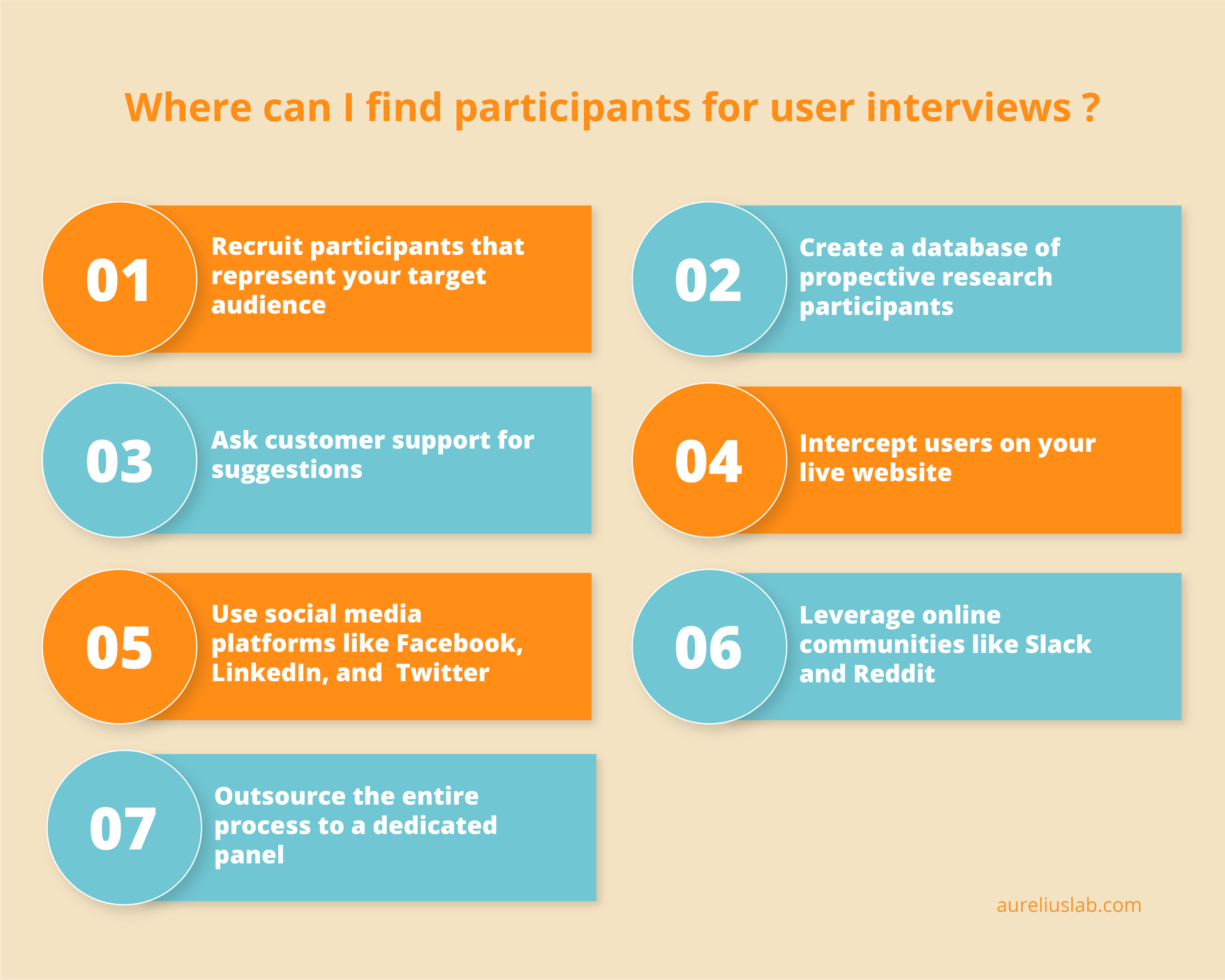
1. Decide Whom to Recruit
As a rule of thumb, you should recruit participants that represent your end-users. Characteristics could be as narrow or broad as the scope of the project. However, it’s crucial to have a diverse group and to consider accessibility, such as how disabled users would interact with your design.
To prevent bias, avoid recruiting your colleagues, family members, or close friends. They may feel obliged to say nice things about the product which defeats the purpose of the research.
Also, avoid recruiting many participants from one profession. Interaction Design describes this risk as deformation professionelle.
For example, if you’re creating a robot vacuum and you only invite women 35 and older, you risk alienating men or younger people who may have a need for the product. This demographic provides feedback based on their knowledge of similar solutions and it could lead to dysfunctional products that are unable to please. Make sure you’re capturing participants across all segments of your audience.
However, none of this would be possible if you haven’t mapped out buyer personas to guide recruitment.
2. Build Research Panels
Building a database of prospective research participants requires time investment. However, it creates a sustainable process for finding research candidates quickly. A research panel also ensures that you’re contacting people who are interested in your product.
Use the following research methodologies to help:
3. Through Customer Support
Since customer support teams have direct interactions with customers, they can help you identify participants for research projects. They regularly get feedback from customers who want to suggest future product improvements or complain about features that aren’t working for them.
4. Live Intercepts
Live intercept is an affordable way to capture users in real-time as they’re doing tasks. You can use tools like Ethnio to identify and screen website uses who may be a good fit for your research.
Neilsen Norman used this technique to recruit participants for a moderated usability study aimed at evaluating the success of their content.

Image Source: NNN Group
If users qualify, you can schedule a conversation and include other researchers to observe remotely.
5. Social Media
Social media is a great way to show your target audience that you’re invested in improving product experience as well as promoting the role of research in your company.
If you have a decent to a large following on social media platforms, ask your followers if they would like to participate in your research project.
For example, if your target audience is a group of mums with toddlers, you could search Facebook for relevant communities. Here’s a sample result
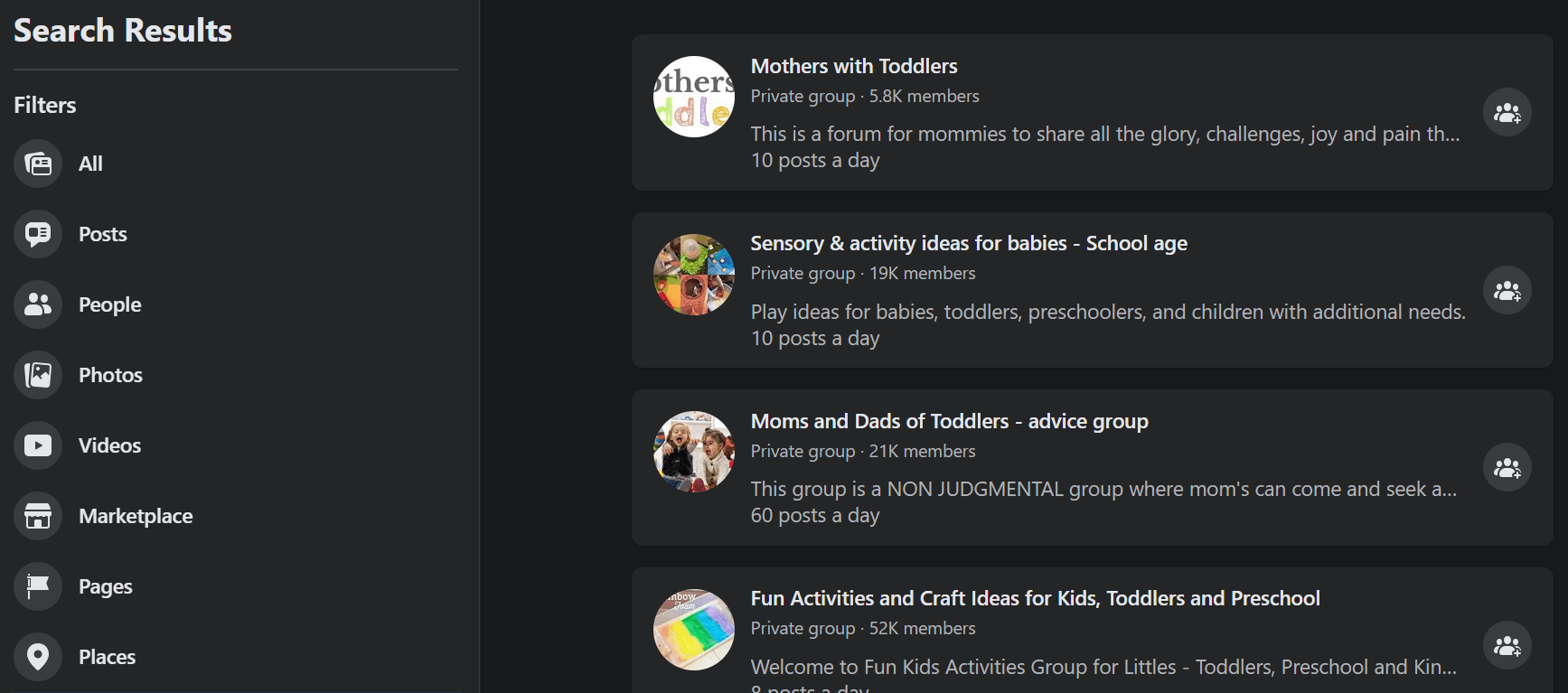
Conversely, if the product is for SaaS founders, you could find participants both on Facebook and LinkedIn communities.

Where does your target audience hang out? That’s where you want to be.
6. Search Online communities
Similar to social media, online communities like Reddit and Slack channels have ready-made participants waiting for you.
If you’re creating software to improve product design, you’d want a group of product designers for your user interview. I searched Google for “product design Slack” and this featured snippet came up.
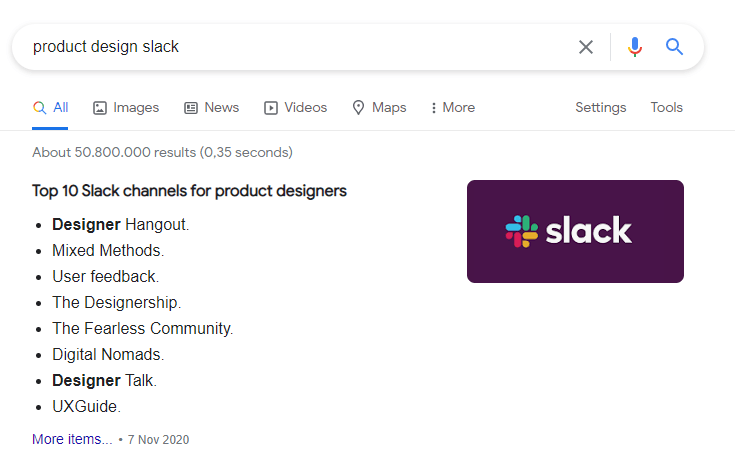
How to Conduct User Interviews?

Before the interview
Screen Participants
At this stage, you have a list of participants, but not everyone is going to be a great fit for your project. Screening user research participants help you find candidates who represent your ideal target audience.
A few tips to help ensure screening success include:
- Define the attributes you want to see in participants such as behaviors, psychographics, and demographics
- Ensure you have a diverse pool of candidates
- Write down your screener questions based on the attributes above
- Ask qualifying questions at the beginning of the survey
- Use a survey tool to build a library of screening questions
- Use accessible language and avoid jargon-speak
- Limit the number of open-ended questions
- Keep the screener short and precise
- Start broad and get narrow as you progress
Determine Incentives for Participants
Incentives are a great way to entice participants for UX research. When determining incentives, make sure it’s commensurate with the time and efforts of participants or you’ll risk a low response rate.
Ensure that people aren’t signing up just for the money or their responses might not be as insightful. An NN Group research found that 63% of incentives are monetary, 13% received a mix of monetary and non-monetary incentives and 9% didn’t receive an incentive.

However, non-monetary incentives tend to be the norm for remote interviews. An Amazon gift card or prepaid visa card ensures participants show up and are engaged during the interview process.
Set Clear Goals
It’s crucial that you have a clear purpose for each interview project.
A few questions to guide you here include:
- What information do I need from our users?
- How will the knowledge inform the UX design process?
- What do stakeholders want to learn from the research?
Make sure stakeholder goals are realistic. Broad goals make it impossible to get feedback that is relevant to your UX design needs.
Prepare for the Interview
Allocate sufficient time for each interview and prep time between interviews. You’ll need to go through your interview guide to feel confident when starting the interview.
Write Down Your UX Research Interview Questions
Never go into a user interview without a discussion guide. This is not the place to “wing it”. A discussion guide is a document that contains a list of questions to ask research participants. It must be tied to the purpose of the research and chosen according to your learning goal.
Preparing a list of questions ensures that you will:
- Include your team’s feedback in the interview process
- Write clear and concise question
- Cover all the questions you wanted to ask, which wouldn’t be possible on the spot
Here are Some User Interview Questions to Get the Most Insight
Discovery Questions
- Tell us about yourself and your background?
- How did you feel before this product?
- What are the problems you want this product to solve for you?
- How did you feel after you started using this product?
- If this company went out of business, what alternative would you use instead?
- What do you like about the product?
- What do you dislike about the product?
- What apps do you use regularly for the tasks?
- What is the hardest part of completing the task?
- Please describe your experience with… or how you use the product?
- How much do you know about this topic?
- How often do you use similar products?
- What exactly do you use the product for?
- Why do you use the product?
- What could be done to make the product better for you?
Questions to Gather User Behavior
- How would you describe your current or past experience with the product, app or website?
- What is the most important task you need to perform with the product?
- How do you navigate to the product? If it’s a website or app, do you use search engines, enter the URL directly or bookmark the site?
- What do you often look for that's missing or hard to find when using this product or application?
- If you had a question about this product do you know who to contact? If yes, whom would you contact?
Question About Past and Future Use
- Can you recall a past situation when you faced a challenge with this problem? What did you do?
- What’s your most memorable interaction with the product?
- If you could picture it, what does the ideal product experience look like?
- What are the most important features of the product?
- How do you usually access the product? Via desktop, tablet, or mobile? (If the product is a software or website)
- What would make you stop using this product?
Specific Task Questions
- Could you show me how you use the product to perform the task?
- Assume that I’ve never used this product before. How would you guide me so I can do it myself next time?
- Walk me through your process for using the product to complete a task
- Do you include other tools alongside the product?
- If yes, can you show me how you integrate the tools and what functions they perform?
Follow Up Questions
Use follow-up questions to dig deeper into a topic. Most times, the participant won’t be clear enough with their answer, and follow-up questions help you to better understand their point of view.
Use the Five Whys Technique to drill down to the root of the problem by asking “why” five times. Without asking “why” you may misinterpret the motivations for the research participant.
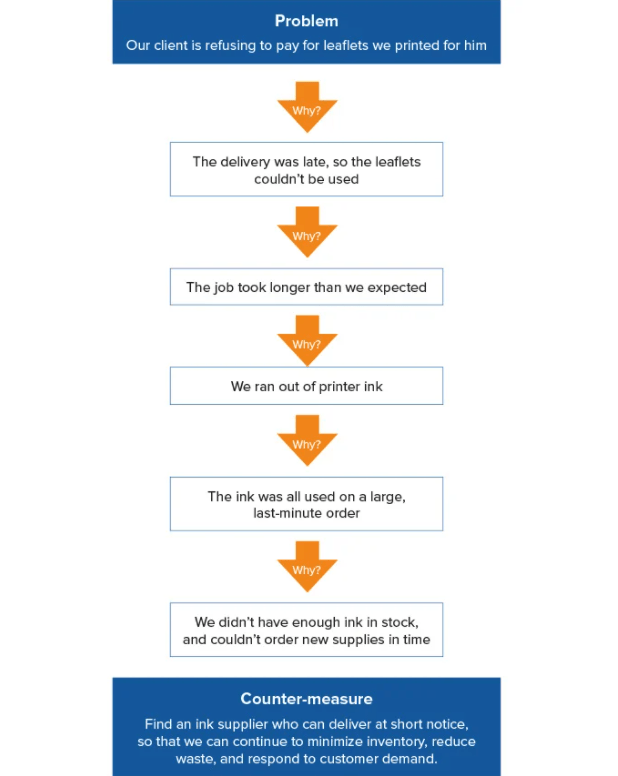
However, it’s also important to know when to stop. You’ve uncovered the problem when the question “why” doesn’t yield any useful response and can’t go any further.
Other examples of follow up questions include:
- You said… can you explain a bit more about that point?
- What do you mean by…
- Interesting, could you give me an example or elaborate to help me understand better?
- To be clear, it sounds like you’re saying… is that correct?
- What was it about the product that made you say…
- Why don’t you like…
Question to Close the Interview
- Would you recommend this product to someone else? If yes, why? If not, why?
- Is there any question we haven’t asked that you think would be valuable to our research?
- Is it okay if I reach out with more questions regarding this project?
- Do you have any questions for me?
During the interview
Make Your Interviewee Feel Comfortable
Take a deep breath and smile before you enter the interview room. According to Psychology Today, a smile is a powerful tool to improve your mood and make you feel happy. Since positivity is contagious, research participants will feel more at ease during the interview.
Also, dress casually rather than wearing a formal outfit so it doesn’t feel like a job interview. Tell them you�’re here to test a product, not the participant.
With remote interviews, start with small talk to loosen them up. Introduce yourself, tell them about the research, and summarize their rights and terms of participation.
Use a Semi-Structured Interview Format to Encourage Dialogue
In a semi-structured interview, you don’t follow a formal list of questions. Rather than yes or no questions, you ask open-ended questions that allow for discussion.
A semi-structured interview encourages a two-way conversation that leads to a comprehensive understanding of the topic. Since the interviewee is at ease, they are more likely to expand on experiences and techniques that offer better insight.
Resist the Urge to Educate
Curiosity and an open mind are key ingredients to a good interview. You’re there to learn, not teach. Do not judge or correct your interviewee no matter how silly their answers seem. Your goal is to get as much information during the limited time for the interview.
Build Rapport with Participants
Building rapport encourages participants to share their thoughts and opinions. Put yourself in their shoes for a moment. You’re walking into a room to speak with strangers. Subconsciously, you censor your thoughts and withhold information because you’re not sure what to say.
Rapport equals a good connection. If participants trust you, they are more forthcoming in their answers.
A few tips to help you build rapport during UX interviews include:
- Be accommodating
- Keep your body language open at all times
- Remove barriers between you and the participant
- Make eye contact
- Show interest
Avoid Leading Questions that Frame the User’s Answer
Leading questions prompt the interviewee to provide a predetermined answer. The question contains information that leads to a biased answer.
Let participants tell you what they think with their words. Don’t fear the silence that takes longer than normal. Sometimes, people need a minute to gather their thoughts and provide a cohesive answer.
Listen
It’s important to have a partner with you during the interview. One person is taking notes and out of camera focus. The second person is asking questions and listening to the interviewee.
Practice asking follow-up questions to show the participant that you’re paying attention. Use smiles and head nods to engage physically.
The space between the note taker and interviewer should be clear. During remote sessions, you could turn off the camera for the note-taker so it’s easier for the interviewer and interviewee to focus on each other.
After the interview
Ask Permission to Use the Recording
If you’re recording the conversation, make sure participants give consent to being recorded as well as how you plan to use the recording. It’s also important that they know they can stop the recording at any point in the interview if they become uncomfortable.
Say Thank You and Wrap Up
After the interview, leave time for questions and thank the research participant for their time. This is polite and offers them a chance to ask questions. If they have any feedback on how you could better conduct interviews in the future, now’s a good time to ask.
How to Analyze User Interviews with Aurelius
After conducting the interviews with all the participants, the next step is to analyze the research. You probably have dozens of notes, videos, and audio recordings to go through. Qualitative data like this could be overwhelming if you don’t know what to do.
This is where Aurelius shines best. Here are a few ways Aurelius helps you make sense of user interview data:
Turn Spreadsheets, Videos, Audio Files and More Into Notes
Create a new project, upload your research notes, spreadsheets, video, and audio recording with the magic uploader. If you’ve got data elsewhere, use the bulk input feature to copy and paste data.
Transcribe your video/audio recording into notes automatically.

Here’s a video showing you how to get notes into Aurelius
Find Information Quickly With Tags
Make sense of your research data with our powerful project tags. Use this feature to find or describe your user interviews quickly.
A few examples of tags to use include:
- Name of interviewee
- Research goals
- Questions asked during the interview
- Name of product or topic
Look for Patterns With Keywords
Looking for patterns or words that come up repeatedly? Use the keyword feature to highlight patterns and find the most used words across all your user interviews.

Highlight Your Major Findings With Key Insights
Use key insights to write down summaries of what you learned from each user interview. It’s a great way to share high level points of the research without asking stakeholders to read all the data.
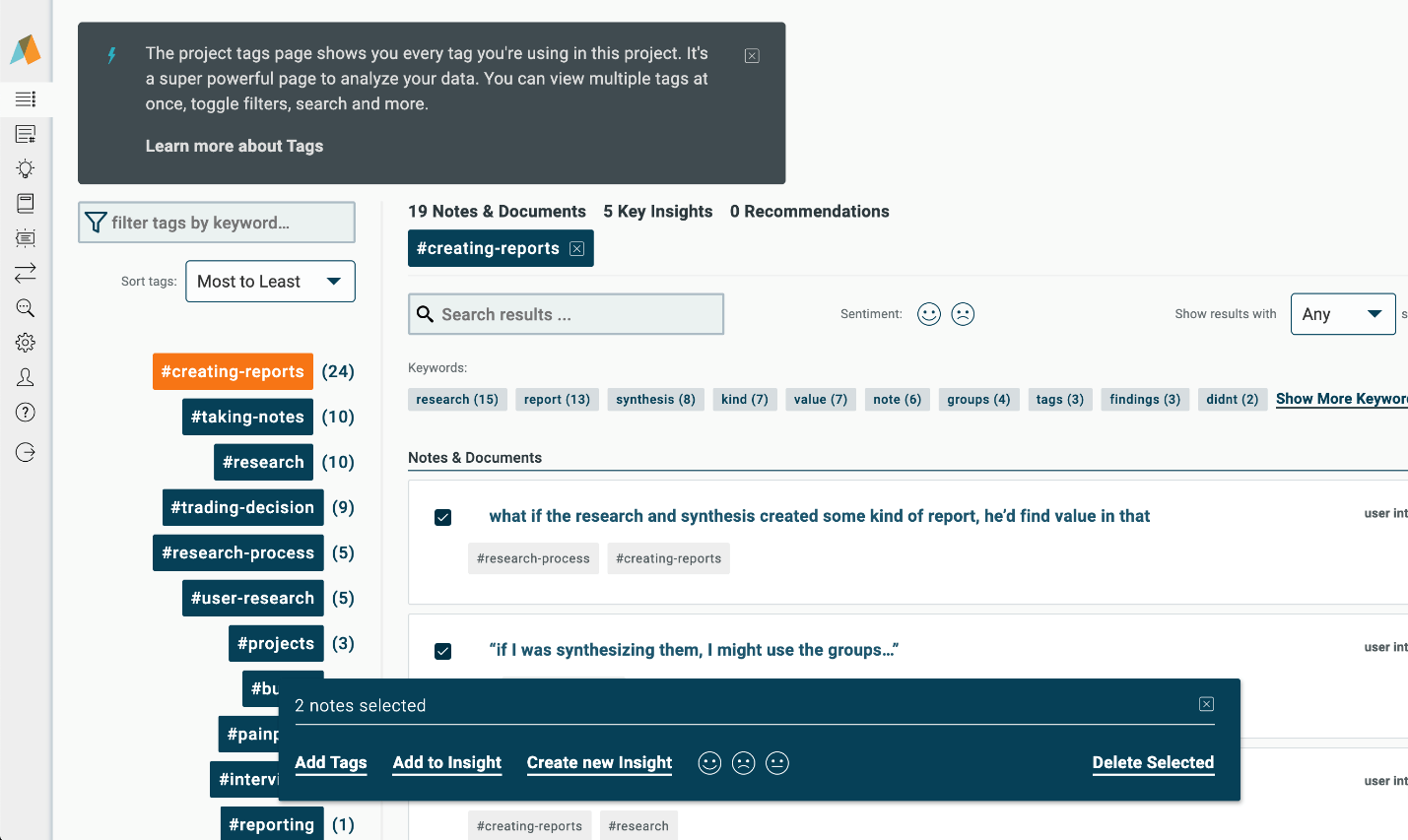
Make Suggestions With Recommendations
Want to suggest next steps based on key insights? Use the recommendations feature to capture suggestions, action items, or outcomes. Link key insight to provide more context to your recommendations. Aurelius automatically adds your recommendations to the report.
Share Reports And Presentations with Project Stakeholders
Reporting is a breeze with Aurelius. We automatically turn recommendations and key insights from your project into reports that you can edit, design, and share with teammates and project stakeholders. You can customize your reports with documents, text, boxes, and lines.

You can also share a live link to your report, download a pdf or send it via email.
Done Right, User Interviews Help Design Teams to Build User-Friendly Products
You can't build a product for the user without gathering their input. Conduct user interviews to uncover meaningful answers that improve user experience.
Combine user interviews with other research techniques such as user surveys and usability testing to either disprove or validate your hypothesis. When you’ve gathered sufficient data, use Aurelius to sift through the information, find insight, make recommendations and create shareable reports.